
“It was working fine in the morning but is acting weird ever since we integrated the new module.”
“I don’t understand what went wrong. Everything was perfect till we started using input data from another source”
“I wonder why this software is behaving abnormally after we integrated the security module.”
This is just another day in the life of testing teams working on complex applications.
Every application is a multilayer cohesive system of various sub-systems, including the presentation layer, interaction (API) layer, and database. The ecosystem of an application also encompasses hardware resources (servers etc.), third-party plugins, network interfacing and connectivity, external data, etc. Now, these can be tested separately and may individually pass the tests with flying colors, but does that ensure that they will work together just as perfectly? If any of the subsystems fails during integration, the whole software system takes the fall. Hence, it is also important to ensure that all the cogs are working in tandem with each other correctly. This is where End-to-End testing helps by testing the entire application from the beginning to the end. Actual production like data and test environment is used to simulate a real-time scenario to ensure that the application is working as expected from an end user’s perspective.
End-to-End testing, also known as E2E testing, validates the flow of entire software from the beginning to the end along with its interactions with entities like hardware, external libraries, third-party plugins, databases, etc.
A good quality assurance process must include comprehensive End-to-End testing. Let us understand why.
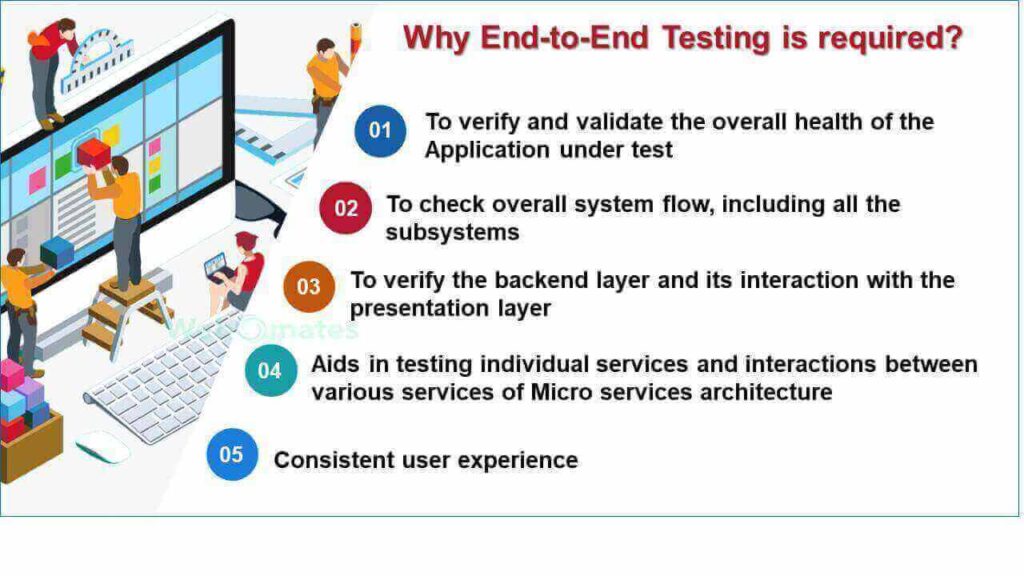
End-to-End testing validates every functionality of the application right from the UI to the backend. It not only provides an overall perspective of the application in terms of how well the requirements have been realized to deliver the expected end product, but also checks for the performance and security aspects.
Software applications are getting increasingly complex and that is why testing has to be comprehensive to cover all possible scenarios. End-to-End testing ensures that the process and data flow is smooth for all the subsystems. There is no margin of error here, since the failure of flow at any point may lead to the failure of the whole system.
Complex applications working on colossal databases coupled with dynamically changing inputs are a perfect recipe for complicated test scenarios. End-to-End testing helps in verifying data integrity and data exchange with the presentation layer in conjunction with the entire process flow.
Micro-services are independent services built around specific business functionalities, each performing its process and communicating with other services via a set of APIs. These services can be developed, deployed, and maintained independently. They can form an ecosystem that represents a larger business scenario, with help of pre-established communication protocols.
End-to-End testing verifies the overall interaction between these services and the application.
The application caters to a wide range of geographically spread users, working on different devices, and running different OS in different environments. One aspect of End-to-End testing is to provide a consistent user experience. Cross-browser compatibility testing is used for that.
There are two common approaches to conducting E2E testing, horizontal and vertical. The following table lists the differences between the two approaches.
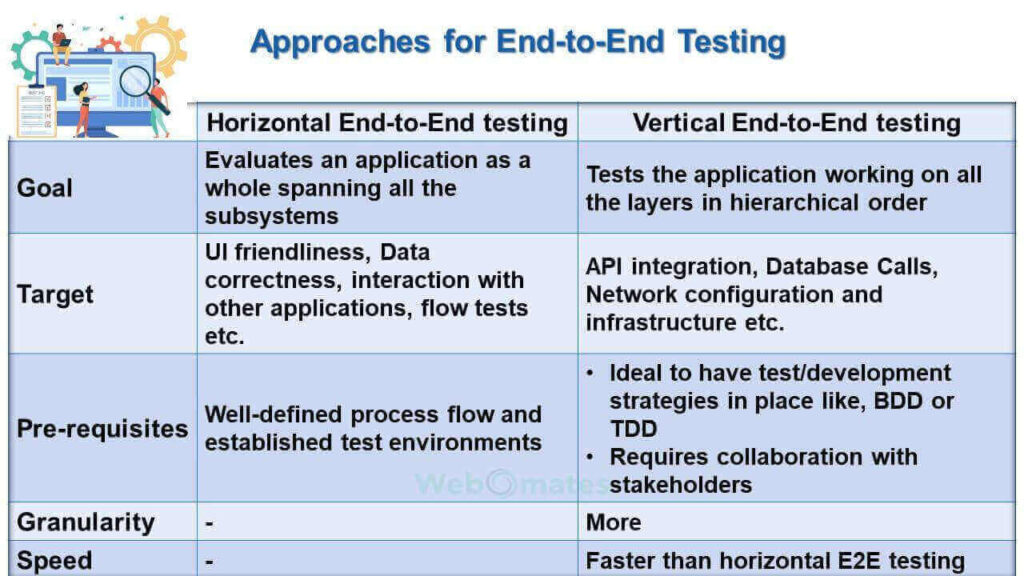
Both approaches hold significant importance in the testing process and depending on the application type and its complexity, either or both of them can be conducted.

End-to-end testing can prove to be very valuable to organizations focused on delivering a consistently high-quality product to their customers. The value attached to End-to-end testing is significant and proves beneficial in the long term.
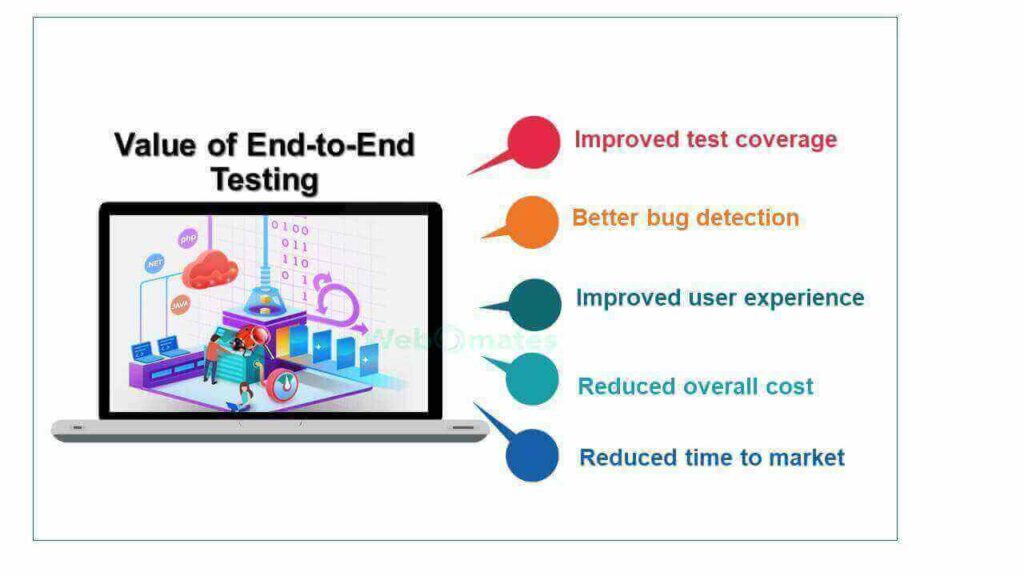
E2E testing helps in expanding test coverage since it targets all the subsystems of the application under test. Any time a sub-system fails, it stalls the whole application. Detailed test cases need to be written to handle such scenarios. Does that sound like a herculean task? Don’t worry… Webomates offers code coverage as an optional add-on to AI test automation.
A huge and complex software has a greater chance of having hidden bugs that cannot be uncovered during unit testing. E2E testing helps in detecting bugs faster and nets most of them since it is conducted more frequently to test the application as a whole. Identifying and rectifying bugs earlier reduces the chances of bugs reaching production, thereby reducing your technical debt accrual.
E2E testing aids in improving user experience, especially for more UI-intensive applications, since it incorporates all the possible test scenarios for data and process flow.
While E2E testing may appear tedious, it has a long-term benefit in terms of overall cost reduction. With a reduced risk of bugs because of repetitive testing, the cost and effort of maintenance go down.
E2E testing makes testing more efficient, thereby reducing time to market.
While there are marked benefits of End-to-end testing, it has certain pitfalls which may make the organizations a bit vary in adopting it.
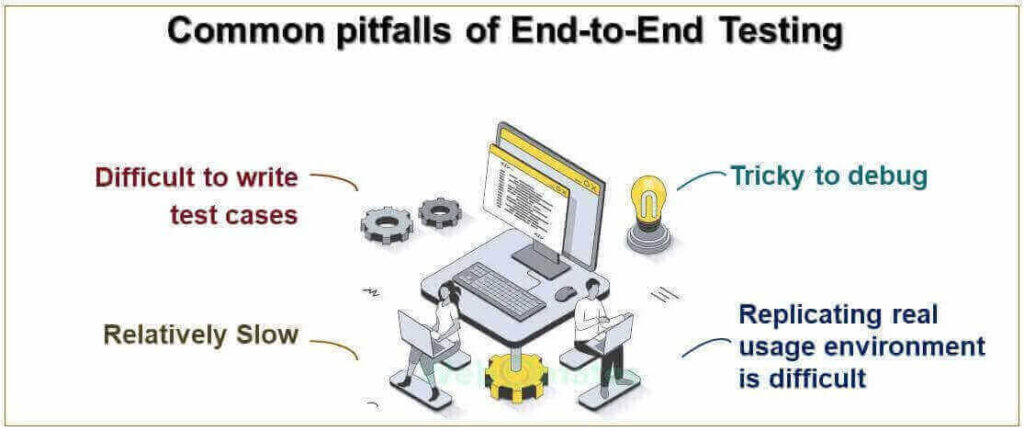
The test cases for E2E testing tend to be very lengthy and detailed since they are designed to reproduce actual user behavior. Given the fact that there are multiple ways a user can act and there could be multiple data and conditional branching based on the inputs, the complexity of the test cases increases. Creating test suites to match this process can be difficult and time-consuming.
E2E testing is a comprehensive form of testing since it verifies process/data flow based on the user’s navigation through the application. Testing all the paths starting right from the UI can take time.
It is much easier to debug smaller test units since tracing the origin of the defect is simpler. However, when an E2E test fails it becomes tricky and time-consuming to trace the defect origin and fix it since it could have originated in any sub-module and propagated further before it was caught.
Recreating the test environment as a replica of the production environment is difficult, resource-intensive, and expensive. For example, simulating geographical location and demographics for GPS-based applications.
Previous sections highlighted the benefits and pointed out the pitfalls of E2E testing. But what will make organizations accept it wholeheartedly?
The answer is simple… Using a cost-effective, intelligent software testing tool that leverages the power of artificial intelligence that accelerates the development velocity.Webomates CQ perfectly fits the bill. Read on to know how.
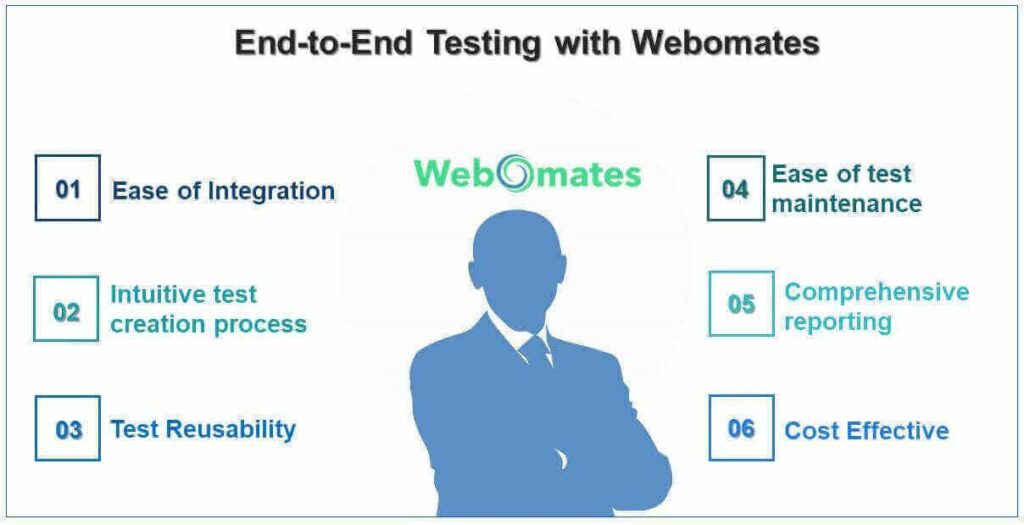
Webomates offers a complete testing solution that seamlessly integrates into your CI/CD pipeline and can be set up within a matter of weeks. Our patented AI Test Strategy and creator helps in devising a well-rounded test strategy for the software.
Webomates’ AI Modeler engine can help you in generating and automating the right test cases, thus reducing the human effort of writing or maintaining the test suite by more than 50%.
There is no need to put extra time, resources, and effort into writing performance and load tests when you use our tool. Functional tests can be easily converted to performance and load tests just with a click. Additionally, all these tests are updated and maintained to reflect any changes in functional tests.
Webomates’ AI engine uses AiHealing to heal the test cases and re-execute them within the same cycle, saving significant time and effort.
Webomates CQ has an exemplary method of triaging and reporting, that aids in faster decision-making and resolutions. Our test reports include a 20-second video of a bug occurring to ease your debugging process.
We also have a provision for scaling up and down testing as per your requirements.
We provide Service level guarantees for
Partner with us to accelerate your quality process with the power of AI. Click here to schedule a demo. You can also reach out to us at info@webomates.com.
If you liked this blog, then please like/follow us Webomates or Aseem.
Tags: AI Testing, complete testing, DevOps, E2E Testing, e2e testing meaning, end to end integration testing, end to end test automation, End to End testing, end-to-end testing automation, end-to-end testing definition, what is end to end testing
Test Smarter, Not Harder: Get Your Free Trial Today!
Start Free Trial
Leave a Reply